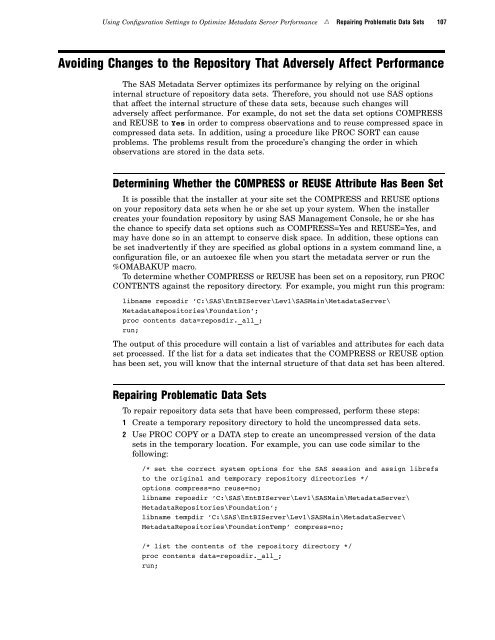SAS 9.1.3 Intelligence Platform: System Administration Guide
SAS 9.1.3 Intelligence Platform: System Administration Guide
SAS 9.1.3 Intelligence Platform: System Administration Guide
Create successful ePaper yourself
Turn your PDF publications into a flip-book with our unique Google optimized e-Paper software.
Using Configuration Settings to Optimize Metadata Server Performance R Repairing Problematic Data Sets 107<br />
Avoiding Changes to the Repository That Adversely Affect Performance<br />
The <strong>SAS</strong> Metadata Server optimizes its performance by relying on the original<br />
internal structure of repository data sets. Therefore, you should not use <strong>SAS</strong> options<br />
that affect the internal structure of these data sets, because such changes will<br />
adversely affect performance. For example, do not set the data set options COMPRESS<br />
and REUSE to Yes in order to compress observations and to reuse compressed space in<br />
compressed data sets. In addition, using a procedure like PROC SORT can cause<br />
problems. The problems result from the procedure’s changing the order in which<br />
observations are stored in the data sets.<br />
Determining Whether the COMPRESS or REUSE Attribute Has Been Set<br />
It is possible that the installer at your site set the COMPRESS and REUSE options<br />
on your repository data sets when he or she set up your system. When the installer<br />
creates your foundation repository by using <strong>SAS</strong> Management Console, he or she has<br />
the chance to specify data set options such as COMPRESS=Yes and REUSE=Yes, and<br />
may have done so in an attempt to conserve disk space. In addition, these options can<br />
be set inadvertently if they are specified as global options in a system command line, a<br />
configuration file, or an autoexec file when you start the metadata server or run the<br />
%OMABAKUP macro.<br />
To determine whether COMPRESS or REUSE has been set on a repository, run PROC<br />
CONTENTS against the repository directory. For example, you might run this program:<br />
libname reposdir ’C:\<strong>SAS</strong>\EntBIServer\Lev1\<strong>SAS</strong>Main\MetadataServer\<br />
MetadataRepositories\Foundation’;<br />
proc contents data=reposdir._all_;<br />
run;<br />
The output of this procedure will contain a list of variables and attributes for each data<br />
set processed. If the list for a data set indicates that the COMPRESS or REUSE option<br />
has been set, you will know that the internal structure of that data set has been altered.<br />
Repairing Problematic Data Sets<br />
To repair repository data sets that have been compressed, perform these steps:<br />
1 Create a temporary repository directory to hold the uncompressed data sets.<br />
2 Use PROC COPY or a DATA step to create an uncompressed version of the data<br />
sets in the temporary location. For example, you can use code similar to the<br />
following:<br />
/* set the correct system options for the <strong>SAS</strong> session and assign librefs<br />
to the original and temporary repository directories */<br />
options compress=no reuse=no;<br />
libname reposdir ’C:\<strong>SAS</strong>\EntBIServer\Lev1\<strong>SAS</strong>Main\MetadataServer\<br />
MetadataRepositories\Foundation’;<br />
libname tempdir ’C:\<strong>SAS</strong>\EntBIServer\Lev1\<strong>SAS</strong>Main\MetadataServer\<br />
MetadataRepositories\FoundationTemp’ compress=no;<br />
/* list the contents of the repository directory */<br />
proc contents data=reposdir._all_;<br />
run;
















